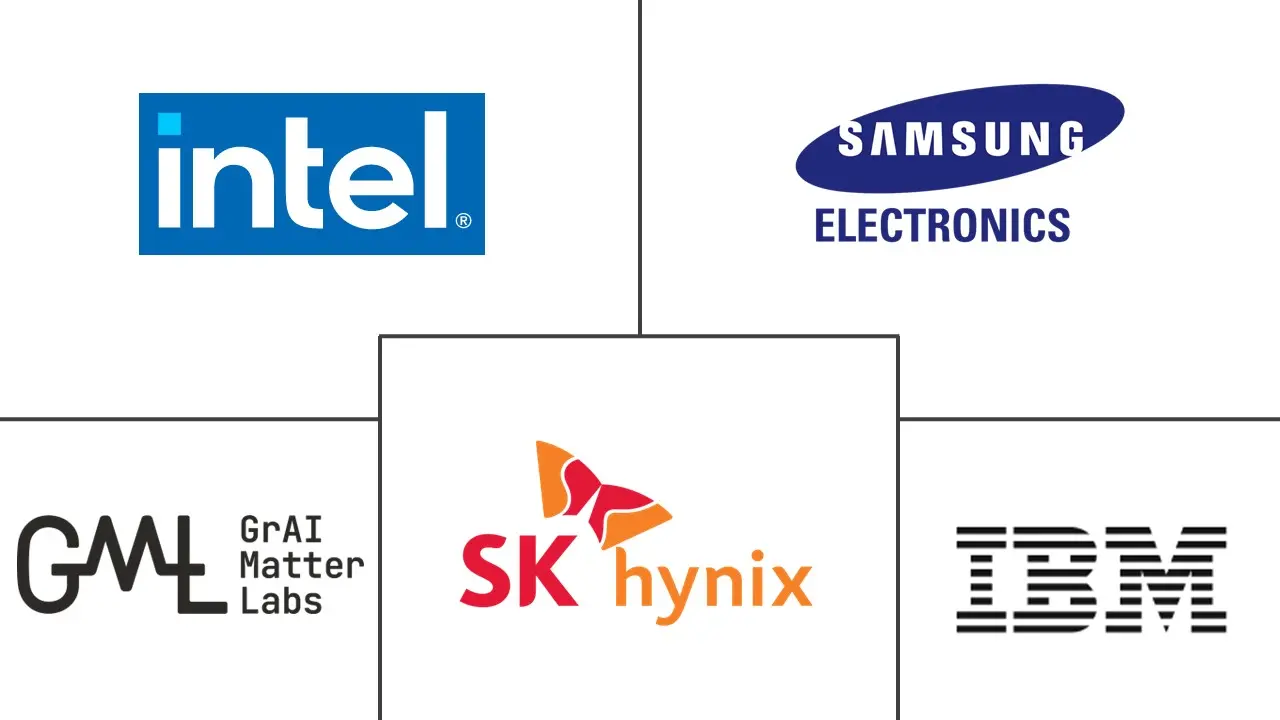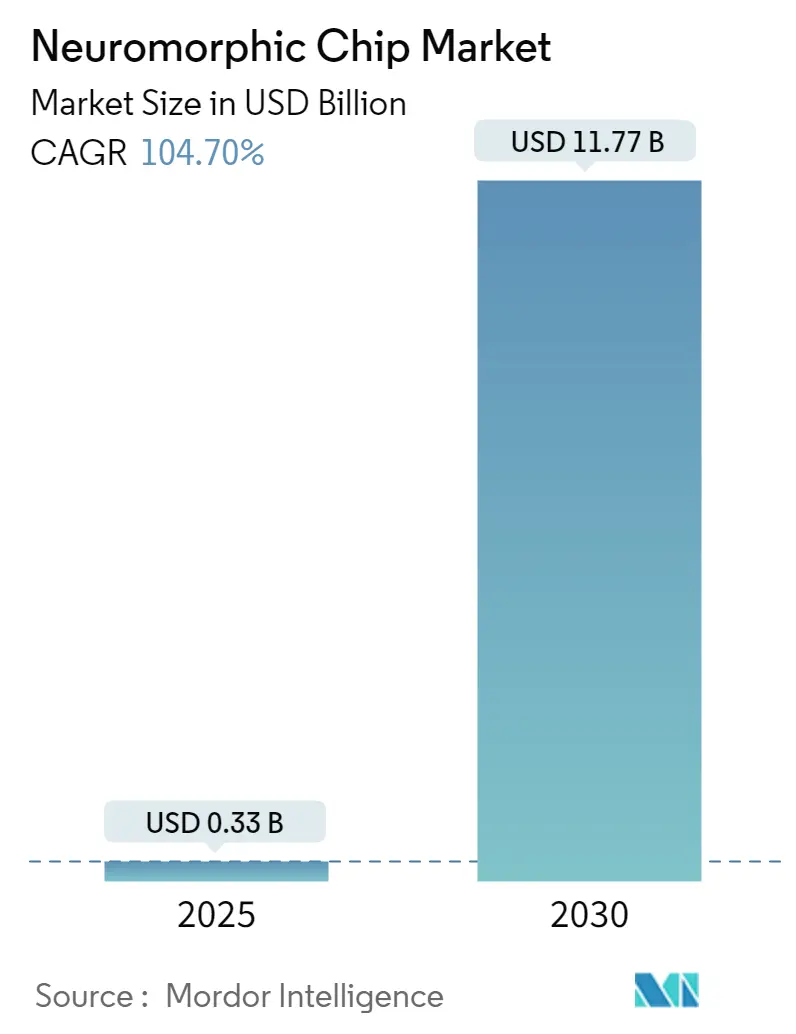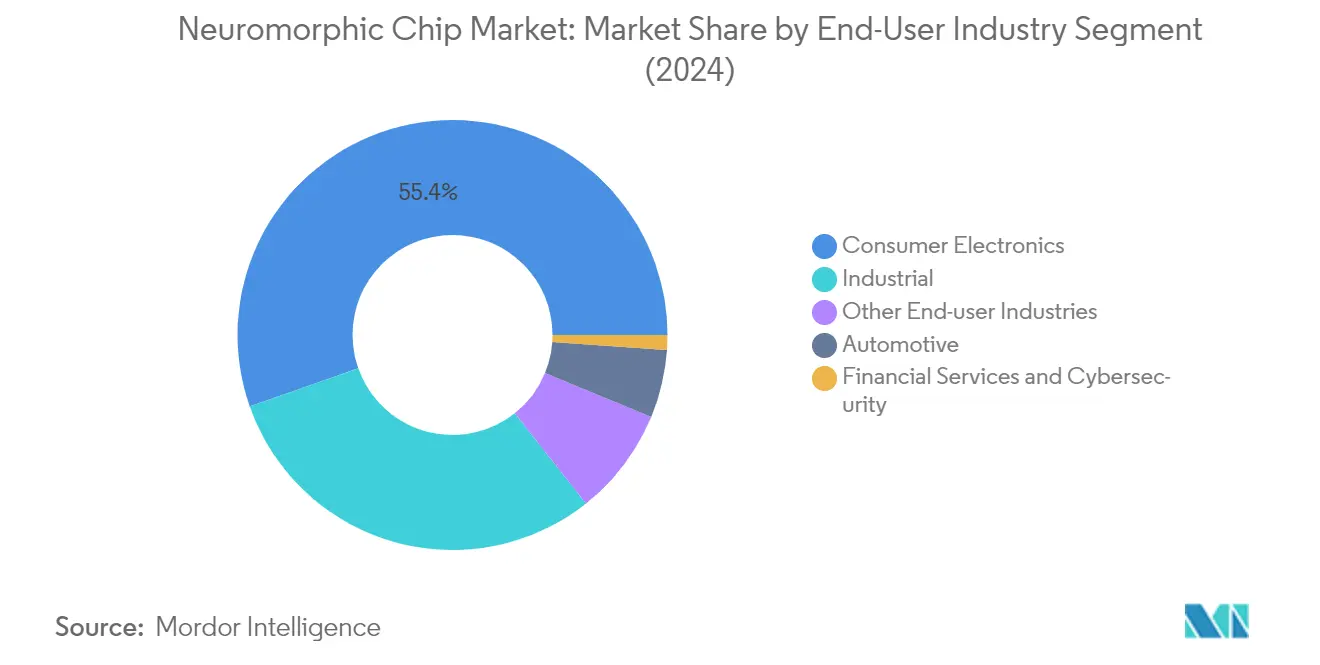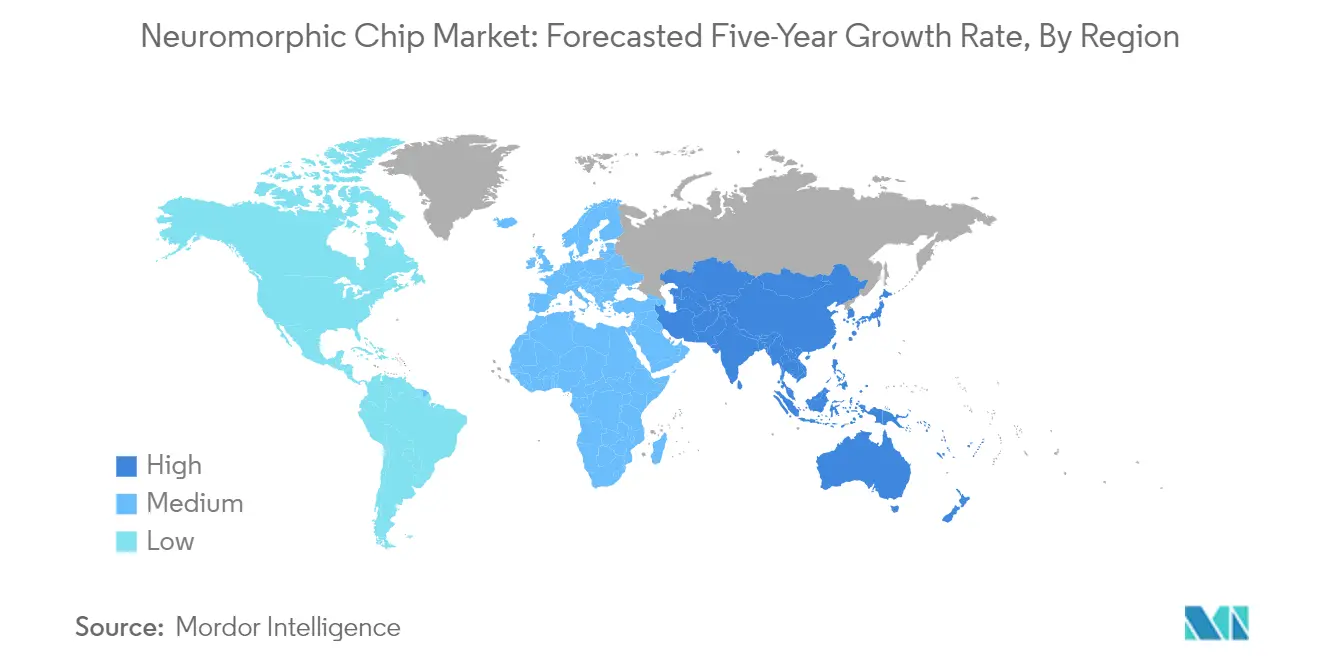Neuromorphic Chip Market Analysis
The Neuromorphic Chip Market size is estimated at USD 0.33 billion in 2025, and is expected to reach USD 11.77 billion by 2030, at a CAGR of 104.7% during the forecast period (2025-2030).
The neuromorphic chip industry is witnessing transformative developments in computational architecture and capabilities, driven by the increasing complexity of modern computing requirements. These chips implement Spiked Neural Networks (SNNs) that can achieve massive parallel brain processing ability while consuming only tens of watts of power, representing a significant advancement in computing efficiency. The integration of memory and processing units into a single abstraction (in-memory computing) has enabled dynamic, self-programmable behavior in complex environments. According to recent industry data, semiconductor sales reached USD 47 billion in September 2022, highlighting the robust demand for advanced semiconductor technologies.
The industry is experiencing rapid evolution in applications across multiple sectors, particularly in edge computing and mobile applications. Neuromorphic chips are being increasingly deployed in smart sensors, IoT devices, and cognitive computing applications, where their ability to process complex data patterns with minimal energy consumption provides a significant advantage. The technology's adoption is particularly notable in the consumer electronics sector, where the number of connected wearable devices reached 1,105 million in 2022, demonstrating the growing demand for efficient processing solutions in smart devices.
Recent industry developments have shown significant progress in the practical implementation of neuromorphic computing system solutions. In December 2023, Intel launched its latest AI neuromorphic chip, capable of performing data-crunching tasks 1,000 times faster than standard processors while using substantially less power. This advancement has particular significance for applications in industrial equipment, cybersecurity, and smart homes. The technology is also gaining traction in the automotive sector, with major manufacturers like Mercedes-Benz incorporating neuromorphic semiconductor computing in their vehicle designs for enhanced efficiency and autonomous capabilities.
The market is characterized by increasing strategic collaborations and technological innovations aimed at expanding the practical applications of neuromorphic computing. In May 2023, BrainChip and Edge Impulse collaborated to develop next-generation machine learning platforms, focusing on mainstreaming neuromorphic technology based on spiking neural networks. The defense sector has shown particular interest in this technology, with global defense expenditure reaching USD 821.83 billion in 2022 in the United States alone, indicating substantial potential for neuromorphic chip applications in military and defense systems. These developments are driving the industry toward more sophisticated and efficient computing solutions across various sectors.
Neuromorphic Chip Market Trends
Growing Demand for Artificial Intelligence-based Microchips
The increasing adoption of AI-enabled devices and services is driving significant demand for specialized AI microchips, particularly in consumer electronics and edge computing applications. AI services like Alexa and Siri currently rely heavily on cloud computing and internet connectivity for processing commands, creating opportunities for neuromorphic AI chips that can enable intelligent local processing without constant network dependencies. The evolution of smart devices has led to more complex operations like biometrics and speech recognition, which are traditionally power-hungry and data-intensive when processed in the cloud. This growing need for efficient AI processing is evidenced by major investments, such as the National Science Foundation's September 2023 announcement of $45.6 million in funding for 24 research and education initiatives focused on semiconductor technologies, supported by industry leaders including Samsung, Ericsson, IBM, and Intel.
The proliferation of connected devices and increasing data processing requirements further amplify the demand for AI-based microchips. According to Cisco Systems, business internet traffic volume is projected to reach 224.08 billion gigabytes by 2023, highlighting the massive scale of data processing needs. This surge in data processing requirements is particularly evident in the wearable technology sector, where the number of connected devices reached 1,105 million in 2022. These devices require sophisticated AI processing capabilities for functions such as health monitoring, emergency response, and real-time data analysis, driving the need for more efficient and powerful AI microchips that can operate with minimal power consumption while delivering high performance. The integration of neural processing units technology in these chips is crucial for optimizing power efficiency and processing speed.
Emerging Trend of Combining the Concept of Neuroplasticity with Electronics
The integration of neuroplasticity principles into electronic systems represents a revolutionary approach to computing that mimics the human brain's ability to adapt and learn. This trend is exemplified by recent developments such as Los Alamos National Laboratory's June 2023 announcement of a new interface-type memristive device designed for building artificial synapses in next-generation neuromorphic computing. The incorporation of neuroplasticity concepts allows these systems to demonstrate remarkable capabilities in pattern recognition, adaptive learning, and real-time processing, making them particularly valuable for applications in edge computing and intelligent sensors. These systems can perform complex tasks such as visual pattern recognition and speech processing with significantly lower power consumption compared to traditional computing architectures.
The advancement in neuroplastic electronics is driving innovation across multiple sectors, particularly in the development of smart sensors and IoT devices. These neuromorphic systems are designed to process and analyze patterns in text, images, signals, and measurements with substantially less energy and complexity than conventional microprocessors. The technology's ability to enable continuous learning and adaptation makes it particularly valuable for applications requiring real-time decision-making and pattern recognition. This is especially relevant in industrial automation, where according to industry reports, the intelligent manufacturing sector is experiencing significant growth due to the integration of adaptive, brain-inspired computing systems. The combination of neuroplasticity with electronics is also enabling new possibilities in healthcare applications, where devices can learn and adapt to individual user patterns while maintaining energy efficiency and processing speed. The use of artificial neural network chips and neural hardware in these applications enhances their capability to perform complex computations efficiently.
Segment Analysis: By End-User Industry
Consumer Electronics Segment in Neuromorphic Chip Market
The consumer electronics segment dominates the neuromorphic chip companies market, commanding approximately 55% market share in 2024. This significant market position is driven by the increasing demand for high-performance computing and ultra-low power consumption in consumer electronic devices. The integration of voice adaptive technologies and services such as Siri and Alexa has further boosted the segment's growth. The rising adoption of smartphones with advanced features like biometric scanning and IoT-based smart home devices continues to fuel the demand for neuromorphic processor in this sector. Additionally, the segment's growth is supported by the increasing implementation of AI services in speakers and other smart home electronics, where neural processor computing enables better understanding of voice commands regardless of speaking speed or timing.
Automotive Segment in Neuromorphic Chip Market
The automotive segment is emerging as the fastest-growing segment in the neuromorphic chip companies market, with a projected growth rate of approximately 133% during 2024-2029. This exceptional growth is primarily driven by the increasing adoption of neural processor in autonomous vehicles and advanced driver assistance systems (ADAS). The technology's ability to process data with significantly lower power consumption makes it particularly attractive for electric vehicles, where energy efficiency is crucial. Automotive manufacturers are increasingly incorporating neuromorphic processor for applications such as keyword spotting, driver attention monitoring, and passenger behavior analysis. The segment's growth is further accelerated by the technology's capability to enable real-time decision-making in autonomous vehicles and its superior performance in noisy environments.
Remaining Segments in End-User Industry
The industrial segment, encompassing the IoT ecosystem, surveillance, and robotics, represents a significant portion of the market with its extensive applications in smart sensors and industrial automation. The financial services and cybersecurity segment is gaining traction due to its applications in pattern recognition and predictive cybersecurity measures. The other end-user industries segment, which includes medical, space, and defense applications, contributes to the market's diversity through specialized applications such as prosthetics development and space exploration technologies. These segments collectively demonstrate the versatility of neuromorphic chip companies technology across various sectors, each bringing unique requirements and applications that drive innovation in chip design and functionality.
Neuromorphic Chip Market Geography Segment Analysis
Neuromorphic Chip Market in North America
North America continues to dominate the global neuromorphic chip market, commanding approximately 73% of the total neuromorphic chip market share in 2024. The region's leadership position is primarily attributed to the presence of major market vendors like Intel Corporation and IBM Corporation, who maintain significant research and development facilities across the region. The Department of Energy's continued support through substantial funding for neuromorphic computing research projects has created a robust ecosystem for innovation. The region's strong semiconductor manufacturing infrastructure, coupled with advanced research institutions and universities actively participating in neuromorphic computing development, has fostered an environment conducive to technological advancement. Additionally, the growing adoption of AI and machine learning technologies across various sectors, particularly in autonomous vehicles, healthcare, and industrial automation, has created sustained demand for neuromorphic solutions. The presence of a mature venture capital ecosystem and strong intellectual property protection framework has also encouraged startups to pursue innovative neuromorphic computing solutions, further strengthening the region's market position.
Neuromorphic Chip Market in Europe
Europe has emerged as a significant hub for neuromorphic computing innovation, demonstrating approximately 107% growth from 2019 to 2024. The region's market growth is driven by substantial investments in research and development through various European Union initiatives and collaborative research projects. The presence of leading research institutions and universities specializing in neuromorphic computing has created a strong foundation for technological advancement. Europe's automotive industry, particularly in Germany, has been at the forefront of adopting neuromorphic computing solutions for autonomous vehicle development and advanced driver assistance systems. The region's focus on sustainable and energy-efficient computing solutions has also accelerated the adoption of neuromorphic chips across various industrial applications. The strong collaboration between academic institutions, research laboratories, and industry players has created a robust ecosystem for neuromorphic technology development. Furthermore, the region's emphasis on data privacy and security has led to increased interest in edge AI processor market solutions powered by neuromorphic chips.
Neuromorphic Chip Market in Asia-Pacific
The Asia-Pacific region represents the fastest-growing market for neuromorphic chips, with a projected growth rate of approximately 119% from 2024 to 2029. The region's market dynamics are shaped by aggressive investments in artificial intelligence and neuromorphic computing research by countries like China, Japan, and South Korea. The presence of major semiconductor manufacturers and their increasing focus on neuromorphic chip development has created a strong foundation for market growth. The region's robust electronics manufacturing ecosystem, coupled with growing demand for AI-powered devices, has created significant opportunities for neuromorphic chip deployment. The increasing adoption of automation and robotics in manufacturing sectors across Asia-Pacific has further accelerated the demand for neuromorphic computing solutions. Additionally, government initiatives supporting artificial intelligence and neuromorphic computing research have created a favorable environment for market expansion. The region's large consumer electronics market and growing automotive sector have also emerged as key drivers for neuromorphic chip adoption.
Neuromorphic Chip Market in Rest of the World
The Rest of the World region, encompassing Latin America and the Middle East & Africa, represents an emerging market for neuromorphic chips with significant untapped potential. The growth in these regions is primarily driven by increasing investments in artificial intelligence and autonomous technologies, particularly in countries like Saudi Arabia and the United Arab Emirates. Research collaborations between international institutions and local universities have helped establish a foundation for neuromorphic computing development. The automotive sector's gradual shift towards autonomous vehicles in these regions has created new opportunities for neuromorphic chip applications. The increasing focus on smart city initiatives and industrial automation across these regions has also contributed to market growth. Additionally, the growing adoption of AI-powered solutions in various sectors, including healthcare and financial services, has created a steady demand for advanced computing solutions. The regions' emphasis on technological advancement and digital transformation has positioned them as promising markets for future neuromorphic chip deployment.
Neuromorphic Chip Industry Overview
Top Companies in Neuromorphic Chip Market
The neuromorphic chip market features established technology leaders like Intel, IBM, Samsung, and SK Hynix alongside innovative startups such as BrainChip, GrAI Matter Labs, and SynSense AG. Neuromorphic chip companies are heavily investing in research and development to advance their neuromorphic computing capabilities, with a particular focus on developing chips that combine enhanced processing power with reduced energy consumption. Strategic collaborations between chip manufacturers and research institutions have become increasingly common to accelerate innovation and commercialization efforts. The industry is witnessing a surge in patent filings and intellectual property development, especially in areas like spiking neural networks and brain-inspired architectures. Market players are expanding their product portfolios through the introduction of next-generation neuromorphic processors while simultaneously working on improving the programmability and scalability of their existing solutions. There is also a growing emphasis on developing comprehensive software frameworks and development tools to support the adoption of neuromorphic computing technologies.
Market Structure Shows Dynamic Competitive Environment
The neuromorphic chip market exhibits a moderately consolidated structure, with large semiconductor conglomerates holding significant market share through their established research capabilities and manufacturing infrastructure. These major players are complemented by specialized neuromorphic computing startups that bring innovative approaches and focused expertise to specific application areas. The competitive landscape is characterized by extensive collaboration networks, with companies forming strategic partnerships across the value chain, from chip design and manufacturing to software development and application deployment. The market has witnessed increased investment activity, with established players either acquiring promising startups or forming joint ventures to strengthen their technological capabilities and market presence.
The industry demonstrates a clear division between companies focusing on general-purpose neuromorphic processors and those developing application-specific solutions for sectors like automotive, robotics, and edge computing. Market participants are actively engaging in cross-industry collaborations, particularly with end-user industries, to develop tailored neuromorphic computing solutions. The competitive dynamics are further shaped by regional innovation clusters, with significant research and development activities concentrated in North America, Europe, and Asia-Pacific. Companies are increasingly adopting open-source approaches and participating in industry consortiums to accelerate technology development and standardization efforts.
Innovation and Adaptability Drive Market Success
Success in the neuromorphic chip market requires a balanced approach combining technological innovation with strategic market positioning. Incumbent players must maintain their competitive edge through continuous investment in research and development while simultaneously building robust ecosystems around their neuromorphic platforms. Companies need to focus on developing comprehensive solutions that address specific industry pain points, particularly in areas like edge computing, artificial intelligence, and autonomous systems. The ability to provide end-to-end solutions, including hardware, software tools, and development support, is becoming increasingly crucial for market success. Establishing strong partnerships with application developers and system integrators is essential for driving adoption and creating sustainable competitive advantages.
For new entrants and emerging players, differentiation through specialized applications and novel architectural approaches presents a viable path to market success. Companies must carefully navigate the complex intellectual property landscape while building strategic partnerships to access manufacturing capabilities and distribution channels. The market's future will be significantly influenced by the ability to address key challenges such as scalability, programming complexity, and integration with existing systems. Success factors also include developing robust supply chain relationships and maintaining flexibility to adapt to evolving customer requirements and technological standards. Companies must also prepare for potential regulatory developments, particularly in sensitive applications like autonomous vehicles and healthcare, while maintaining focus on sustainability and environmental considerations.
Neuromorphic Chip Market Leaders
-
Intel Corporation
-
SK Hynix Inc.
-
IBM Corporation
-
Samsung Electronics Co. Ltd
-
GrAI Matter Labs
- *Disclaimer: Major Players sorted in no particular order
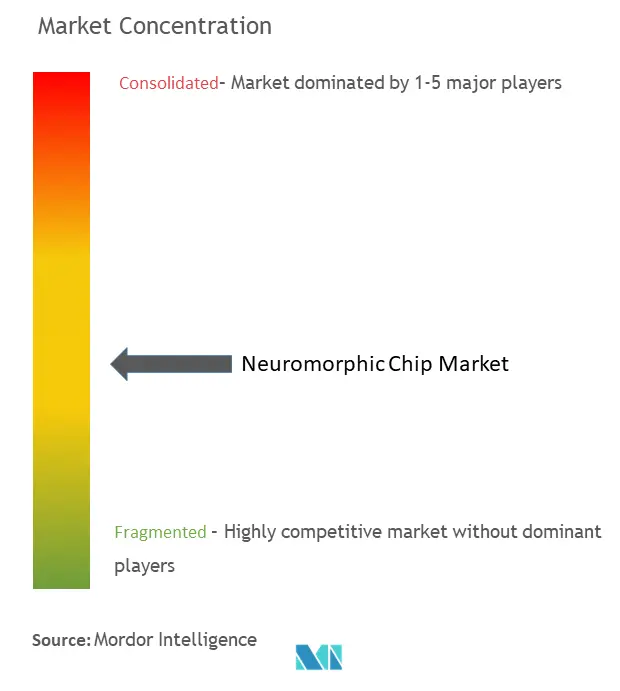
Neuromorphic Chip Market News
• March 2024: Using neuromorphic computing technology, a research team at KAIST created the first artificial intelligence (AI) semiconductor in history to compute a large language model (LLM) with extremely low power consumption. By creating integrated circuits resembling the human nervous system, technology hopes to enable chips to carry out increasingly complex tasks that require flexibility and reasoning while using less energy.
• September 2023: SynSense, the top commercial provider of ultra-low-power neuromorphic hardware and application solutions worldwide, released the Xylo IMU neuromorphic development kit (HDK). This new HDK allows users to create IMU-based motion processing applications for industrial monitoring, human movement analysis, and human-computer interaction. With support for training and deploying SNN models for Xylo IMU, SynSense’s open-source Python toolchain rockpool allows developers to investigate new use cases and research applications.
Neuromorphic Chip Industry Overview
Neuromorphic chips are digitally-processed analog chips with a series of networks similar to human brain networks. These chips contain millions of neurons and synapses to augment self-intelligence, irrespective of pre-installed codes in normal chips. Neuromorphic chips, as a special kind of chip, can manipulate data received through sensors. For the study, chips that adopt the SNN approach have been considered part of the scope. The market studied tracks deep learning hardware and neuromorphic chips as separate markets.
The Neuromorphic Chip Market is segmented by End-User Industry (Financial Services & Cybersecurity, Automotive (ADAS/Autonomous Vehicles), Industrial (IoT Ecosystem, Surveillance, and Robotics), Consumer Electronics), Geography (North America, Europe, Asia Pacific, Rest of the World). The market sizes and forecasts are provided in terms of value (USD) for all the above segments.
| By End-User Industry | Financial Services and Cybersecurity |
| Automotive (ADAS/Autonomous Vehicles) | |
| Industrial (IoT Ecosystem, Surveillance, and Robotics) | |
| Consumer Electronics | |
| Other End-user Industries (Medical, Space, Defense, Etc.) | |
| By Geography | North America |
| Europe | |
| Asia Pacific | |
| Rest of the World |
Neuromorphic Chip Market Research FAQs
How big is the Neuromorphic Chip Market?
The Neuromorphic Chip Market size is expected to reach USD 0.33 billion in 2025 and grow at a CAGR of 104.70% to reach USD 11.77 billion by 2030.
What is the current Neuromorphic Chip Market size?
In 2025, the Neuromorphic Chip Market size is expected to reach USD 0.33 billion.
Who are the key players in Neuromorphic Chip Market?
Intel Corporation, SK Hynix Inc., IBM Corporation, Samsung Electronics Co. Ltd and GrAI Matter Labs are the major companies operating in the Neuromorphic Chip Market.
Which is the fastest growing region in Neuromorphic Chip Market?
Asia-Pacific is estimated to grow at the highest CAGR over the forecast period (2025-2030).
Which region has the biggest share in Neuromorphic Chip Market?
In 2025, the North America accounts for the largest market share in Neuromorphic Chip Market.
What years does this Neuromorphic Chip Market cover, and what was the market size in 2024?
In 2024, the Neuromorphic Chip Market size was estimated at USD -0.02 billion. The report covers the Neuromorphic Chip Market historical market size for years: 2019, 2020, 2021, 2022, 2023 and 2024. The report also forecasts the Neuromorphic Chip Market size for years: 2025, 2026, 2027, 2028, 2029 and 2030.
Our Best Selling Reports
Neuromorphic Chip Market Research
Mordor Intelligence provides a comprehensive analysis of the rapidly evolving neuromorphic chip industry. We leverage our extensive expertise in neural processor technologies and cognitive processor developments. Our research thoroughly examines the advancement of neuromorphic chips and neural processing units. It also offers detailed insights into emerging neuromorphic semiconductor technologies. The report, available as an easy-to-download PDF, delivers in-depth analysis of neuromorphic processor innovations and neural hardware implementations across various industries.
Our detailed market analysis benefits stakeholders by offering crucial insights into neuromorphic chip companies and their technological developments. This includes advancements in edge AI processor innovations and synaptic chip breakthroughs. The report explores computing systems based on neuromorphic technology and their applications. It also covers developments in chips for artificial neural networks and the expanding market for edge AI processors. This comprehensive analysis includes detailed evaluations of neuromorphic AI chip developments, ensuring stakeholders have access to the most current and relevant industry insights for informed decision-making.

